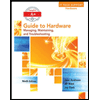
Concept explainers
Domain Name:
The name given to the IP address is called as domain name. Every domain name is unique and they are text based address.
Hence, the correct answer is option “B”.
Explanation of Solution
URL:
- URL is known as Uniform Resource Locator; it is also a type of Uniform Resource Indicator, because, it represents the network location of resource like web pages, graphic files, mp3 files, and so on.
- URL contains:
- A protocol
- Web server name
- Domain name
- Location of the file
Example: “http://www.mozilla.com”
Here,
- http – HTTP protocol
- www – Web server name or host
- mozilla.com – domain name
Domain Name:
The name given to the IP address is called as domain name. Every domain name is unique and they are text based address.
Explanation for incorrect options:
IP address:
IP address will be in the form of numbers. The name given to the IP address is called as domain name.
Hence, the option “A” is wrong
URL:
URL (Uniform Resource Locator) represents the network location of resource like web pages, graphic files, mp3 files, and so on. URL contains: A protocol, Web server name, Domain name, Location of the file.
Hence, the option “C” is wrong.
User Name:
User name is nothing, but a name given by the user. It is not called as the Internet address.
Hence, the option “D” is wrong.
Want to see more full solutions like this?
Chapter 1 Solutions
Web Development and Design Foundations with HTML5 (8th Edition)
- Please solve and answer the questions correctly please. Thank you!!arrow_forwardConsidering the TM example of binary sum ( see attached)do the step-by-step of execution for the binary numbers 1101 and 11. Feel free to use the Formal Language Editor Tool to execute it; Write it down the current state of the tape (including the head position) and indicate the current state of the TM at each step.arrow_forwardI need help on inculding additonal code where I can can do the opposite code of MatLab, where the function of t that I enter becomes the result of F(t), in other words, turning the time-domain f(t) into the frequency-domain function F(s):arrow_forward
 Enhanced Discovering Computers 2017 (Shelly Cashm...Computer ScienceISBN:9781305657458Author:Misty E. Vermaat, Susan L. Sebok, Steven M. Freund, Mark Frydenberg, Jennifer T. CampbellPublisher:Cengage Learning
Enhanced Discovering Computers 2017 (Shelly Cashm...Computer ScienceISBN:9781305657458Author:Misty E. Vermaat, Susan L. Sebok, Steven M. Freund, Mark Frydenberg, Jennifer T. CampbellPublisher:Cengage Learning LINUX+ AND LPIC-1 GDE.TO LINUX CERTIF.Computer ScienceISBN:9781337569798Author:ECKERTPublisher:CENGAGE L
LINUX+ AND LPIC-1 GDE.TO LINUX CERTIF.Computer ScienceISBN:9781337569798Author:ECKERTPublisher:CENGAGE L A+ Guide to Hardware (Standalone Book) (MindTap C...Computer ScienceISBN:9781305266452Author:Jean AndrewsPublisher:Cengage Learning
A+ Guide to Hardware (Standalone Book) (MindTap C...Computer ScienceISBN:9781305266452Author:Jean AndrewsPublisher:Cengage Learning Systems ArchitectureComputer ScienceISBN:9781305080195Author:Stephen D. BurdPublisher:Cengage Learning
Systems ArchitectureComputer ScienceISBN:9781305080195Author:Stephen D. BurdPublisher:Cengage Learning Principles of Information Systems (MindTap Course...Computer ScienceISBN:9781285867168Author:Ralph Stair, George ReynoldsPublisher:Cengage Learning
Principles of Information Systems (MindTap Course...Computer ScienceISBN:9781285867168Author:Ralph Stair, George ReynoldsPublisher:Cengage Learning Principles of Information Systems (MindTap Course...Computer ScienceISBN:9781305971776Author:Ralph Stair, George ReynoldsPublisher:Cengage Learning
Principles of Information Systems (MindTap Course...Computer ScienceISBN:9781305971776Author:Ralph Stair, George ReynoldsPublisher:Cengage Learning





